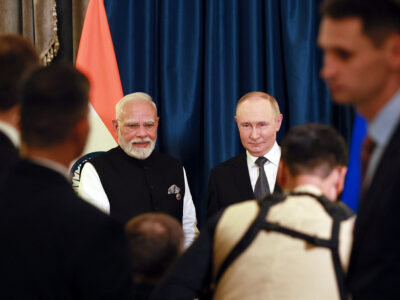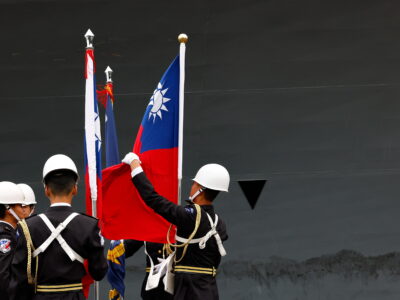APEC Summit 2025: What’s at Stake?
Overview
From Oct. 31 to Nov. 1, representatives of 21 member countries of Asia–Pacific Economic Cooperation, or APEC, will gather in South Korea’s southeastern city of Gyeongju for its annual summit. The APEC summit is a rare multilateral forum where major and developing economies from the East and the West come together to discuss cooperation, and it has played a meaningful facilitating role in promoting shared interests, such as reducing trade barriers and coordinating responses to financial crises. Stakes at this year’s APEC summit are indeed high, as countries face pressing challenges, including economic instability driven by the escalating trade war between the United States and China.
Below, Quincy Institute experts share their assessment of what to expect at the summit.
Jake Werner, director, East Asia program
Chinese President Xi Jinping is obsessed with stability. U.S. President Donald Trump is always trying to throw his interlocutors off-balance. When the two collided in Trump’s first term, the Chinese leadership’s distress was palpable. Xi’s government — lacking both the equanimity and the policy tools to withstand Trump’s sharp pivots between flattery, aggression, and mercenary dealmaking — struggled to respond.
Beijing has confronted the second Trump term in a very different state. The only country to have previously faced the full force of Trump’s belligerence, China was unusually well-prepared for what was to come. The only country capable of matching the centrality of the United States in the global production system, China also has the singular potential to meet Trump’s punitive demands with powerful countermeasures.
China’s leaders are careful students of the United States’ own systematic weaponization of the global financial, information, and supply chain systems to damage rivals. Beijing has spent the last five years establishing a mirror-image system to weaponize its strategic position in mining, processing, and manufacturing. When Trump responded to the initial Chinese offers to negotiate with repeated tariff barrages, Beijing deployed this power, forcing Trump to back down from the de facto trade embargo he imposed in April.
Yet Trump’s search for leverage continued unabated, creating an opening for officials in his administration looking to sink the possibility of a deal. Beijing, in turn, sought to build its own leverage, which keeps Trump from pushing too hard but constantly risks antagonizing him instead. The outcome has been a series of escalations followed by de-escalations.
Following the most recent cycle, Trump and Xi will finally be meeting in person at the APEC leaders’ summit this Thursday, now that both sides have walked back serious threats. The timing is ideal, because Trump is more likely to make an agreement when he has recently exerted his own power and felt the other side’s power as well. Support from the two leaders could open the way for negotiations on a breakthrough agreement, like a framework for large-scale Chinese investment in the United States that Beijing has offered. But if the two sides cannot move past their mutual shoving match, future escalation could send the world into a spiral of great power conflict.
James Park, research associate, East Asia program
The upcoming APEC summit will be an important diplomatic stage for South Korea, the host nation. South Korean President Lee Jae Myung entered office in June with a foreign policy vision of “pragmatic diplomacy,” vowing to pursue close security ties with the United States and Japan while also maintaining stable relations with China, North Korea, and Russia. In this context, Seoul faces potential high-stakes developments at the APEC summit.
Seeking to strengthen cooperation with both Washington and Beijing, Lee is keen to have good bilateral meetings with Presidents Trump and Xi. Although Lee had a positive first meeting with Trump in August, they left a range of key issues, most importantly their tariff and investment negotiations, unfinished. With the South Korean public increasingly fatigued by the uncertainty over U.S. tariffs, Seoul hopes to deliver more concrete results on the trade deal with Washington this time. As the trade talks have dragged on, the two allies have also been distracted from bigger issues in their relationship, such as North Korea and alliance modernization. It remains to be seen whether Lee and Trump can reach an agreement at the APEC summit, but the odds do not seem high, given Trump’s unyielding stance on trade deals.
Lee’s anticipated meeting with Xi will not be easy either. The last time Xi visited South Korea was in 2014, at a high point of South Korea–China bilateral ties. However, relations between the two countries have gone downhill in the aftermath of their contentious 2016–17 dispute over South Korea’s deployment of the U.S. THAAD antimissile system. Through a rare summit with Xi, Lee seeks a positive momentum shift to enhance cooperation with China on key issues, including trade and dealing with North Korea. Nevertheless, while symbolically meaningful, the potential Lee–Xi meeting may have limited impact on driving concrete bilateral cooperation, given persistent tensions in U.S.–China relations and Beijing’s skepticism toward Washington’s regional allies.
At the APEC summit, South Korea should avoid focusing too much on engagement with the United States and with China with the aim of influencing their policies. Instead, Seoul could benefit from prioritizing partnership-building with Tokyo; the countries of the Association of Southeast Asian Nations, or ASEAN; and other middle powers that share a keen interest in navigating both Washington’s and Beijing’s economic coercion and avoiding victimization in their increasingly zero-sum competition. Such middle-power coalition-building efforts will become even more necessary should the possible Trump–Xi summit encounter setbacks and U.S.–China tensions escalate further.
Sarang Shidore, director, Global South program
The 2025 APEC Summit, while hosted by South Korea, holds significant relevance for ASEAN member countries due to shared economic objectives and as a continued anchor for regional stability. The ASEAN nations, with the exception of Laos and Cambodia, are also APEC members, creating direct overlap in their strategic priorities.
In a time when Washington has slapped tariffs on practically every country, APEC may appear out of date. But its founding ideas of encouraging and facilitating open trade and investment continue to resonate in Asia. These ideas also align well with ASEAN’s efforts to deepen regional economic integration through initiatives like the Regional Comprehensive Economic Partnership trade agreement, or RCEP, and the ASEAN Economic Community, or AEC. Other APEC issues — such as supply chain resilience, digital trade, and sustainable economic growth — are all critical for ASEAN’s continued development and its role as a manufacturing and trade hub.
Though Southeast Asia has continued to grow reasonably well despite a flood of U.S. tariffs, it has recently experienced a degree of instability. The civil war in Myanmar continues to rage and has become even worse in some respects. Tensions have risen sharply in the South China Sea with Chinese maritime intrusions and clashes with the Philippines. In July, Thailand and Cambodia engaged in a five-day armed clash over their disputed border, and its economic effects are still taking a toll. In such a period of uncertainty, ASEAN states can benefit by further deepening their activities in APEC, thereby embedding themselves more deeply in the broader Asia–Pacific region.
At the summit, all eyes will be on a likely meeting between Presidents Xi and Trump. The latter has spoken of achieving a “great trade deal.” Southeast Asia will be among those most strongly hoping for a breakthrough. The spike in tensions on the security and economic fronts between Washington and Beijing worries the region, as much of its prosperity stems from maintaining good ties with both great powers in a world in which great power competition is managed and contained. ASEAN states would prefer to hedge and maximize benefits from both sides in their quest for greater prosperity for their peoples.
Karthik Sankaran, senior research fellow, Global South program
Much of the attention at the APEC summit will focus on whether a meeting between Presidents Xi and Trump leads to a trade thaw. However, the EC in APEC stands for “Economic Cooperation,” something other member states take very seriously. The host country’s ambitions for the agenda are very high. These include “fostering a free, open, fair, non-discriminatory, transparent, and predictable trade and investment environment” and proposing to “collaboratively unlock AI’s potential, enhancing competitiveness and addressing shared challenges among APEC member economies.”
Given the extent to which both APEC giants are resorting to trade barriers, export controls, and extraterritoriality to push “secondary decoupling,” the above could be a bridge too far, but even a partial de-escalation would be welcome. A joint statement on Oct. 21 from the meeting of finance ministers (attended by lower-level representatives from both the United States and China) did agree to “facilitate the accelerated flow of innovation within the Asia–Pacific region,” which is perhaps a hopeful sign. Similarly, the joint statement of APEC energy ministers in August acknowledged that rising electricity demand meant a role for both renewables and natural gas, giving Washington a win (and a spur for deals).
However, APEC also includes 19 other economies convinced of the need to deepen cross-border economic engagement. At the recently concluded International Monetary Fund/World Bank meetings, most participants stressed that they remain committed to expanding trade. Countries have done “deals” with Trump to avoid tariff escalation, but in their dealings with one another, the emphasis is on creating or firming up an architecture of global trade that can at least survive, or even thrive, without U.S. participation.
And many countries at APEC are active members of one or more plurilateral trade groupings: the Comprehensive and Progressive Agreement for Trans–Pacific Partnership, or CPTPP (the successor to the original Trans–Pacific Partnership, which the United States refused to join); ASEAN; RCEP; and APEC itself. All these groupings are talking about further expansion of trade agreements and reforming a World Trade Organization whose dispute resolution mechanism has been hobbled. So, a key part of this APEC summit could feature lower-key discussions that will begin to chart the path toward a new Asian trade order that does not center on the United States.








